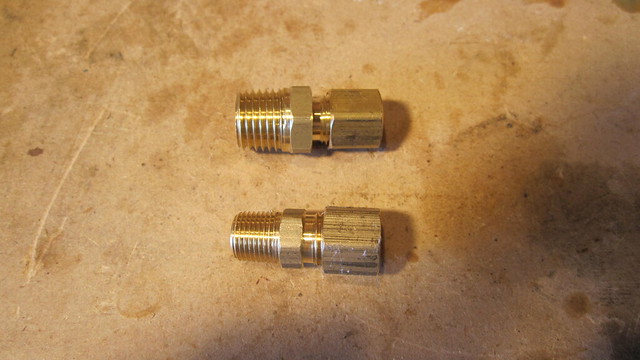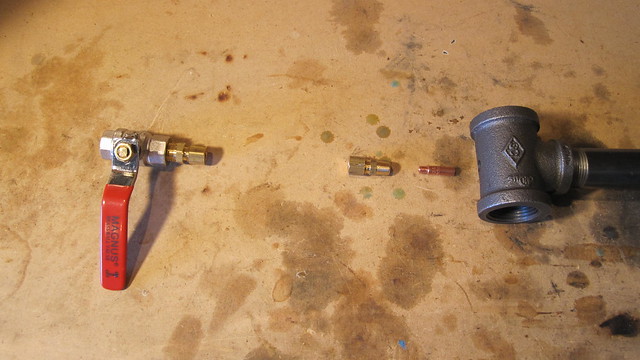Well, like the title says, I'm building a portable raised garden bed. Best of all, it's simple to make and super easy to move. It's the ideal urban garden solution. Let's get started!
If you don't have a chop saw like me, you can head over to your local big box store and get your wood cut. They're not super precise, and they charge about 50 cents per cut, but for our purposes the precision is good enough—and if it's your only solution, you have to do with what you got.
I used this plan for a raised garden bed as a template, and customized from there. I'm making a bed that's about 3' by 4' (or 36" by 48"). The structure is also going to be 3' high, and the actual bed, 14" deep.
Here are the specs:
Buy List:
2 – 2x4x12 – legs, small supports
1 – 2x4x8 – bottom supports
7 – 1x4x12 - “flooring”, part of siding (long), part of siding (small)
2 – 1x4x8 – part of siding (small), part of siding (long)
4 – casters
Landscaping fabric
Wood screws
Breakdown:
1 – 2x4x12 – legs
1 – 2x4x12 – small supports
1 – 2x4x8 – bottom supports
3 – 1x4x12 - “flooring”
2 – 1x4x12 – siding (long)
1 – 1x4x8 – siding (long)
2 – 1x4x12 – siding (small)
1 – 1x4x8 – siding (small)
Cut List (refer to the Breakdown list above):
Legs – 36” each – 4 pieces
Small Supports – 36” each – 4 pieces
Bottom Supports – 48” each – 2 pieces
Flooring – 48” each – 9 pieces
Siding (long) – 48” each – 8 pieces
Siding (small) – 40.62” each – 8 pieces
That's all for now,
Zachary
A Creative DIY-ist Journal
w o o d w o r k i n g. b o w m a k i n g. k n i f e m a k i n g.
Tuesday, January 8, 2013
Tuesday, August 28, 2012
Burner Complete!
It has been a long time since I last posted. In fact, I already finished the burner many months ago. However, I thought I'd show you all how it works/looks. It's really hot here in Arizona, so I can't forge until winter time.
Thursday, January 5, 2012
Burner Almost complete
Almost all the pieces for the burner (I got one of the wrong taps, which I need to go get at Lowes along with the copper pipe)


Here I already drilled the hole at the top of the "T". I also attached a brass piece that I had in a box of fittings. I'm not sure what it is, exactly, but I kind of acts like a flare and enables me to attach the burner to the hole in the firebrick.

These are two different compression fittings. The top one is 1/4" MPT x 1/4" compression. The bottom one is 1/8" MPT x 1/4" compression. Why? Scroll down.

Here's the setup. From right to left:
Gas comes in through a 1/4" hose into the the 1/4" x 1/4" Ball Shut-off Valve
On the other side of the valve, there is the 1/4" MPT x 1/4" compression fitting
This attaches to the 1/4" copper pipe (Not shown--I don't have it yet)
The other end of the copper pipe attaches to the other 1/8" MPT x 1/4" compression fitting
The 0.035 MIG tipscrews into the tapped 1/8" MPT side of the 1/8" MPT x 1/4" compression fitting (Use 1/4-28 tap with a #3 drill bit)
The 1/8" MPT x 1/4" compression fitting then screws into the tapped "T" (Use 1/8-27 Tapered Tap)
For more information and if you need to ask any questions, go here: http://www.iforgeiro...-and-made-this/
What's left to buy: Firebrick! (Regulator and hose are shipping. Should get them by next week)
Can't wait to get this burner up and running... building the forge should be the really easy part.
Zachary


Here I already drilled the hole at the top of the "T". I also attached a brass piece that I had in a box of fittings. I'm not sure what it is, exactly, but I kind of acts like a flare and enables me to attach the burner to the hole in the firebrick.

These are two different compression fittings. The top one is 1/4" MPT x 1/4" compression. The bottom one is 1/8" MPT x 1/4" compression. Why? Scroll down.

Here's the setup. From right to left:
Gas comes in through a 1/4" hose into the the 1/4" x 1/4" Ball Shut-off Valve
On the other side of the valve, there is the 1/4" MPT x 1/4" compression fitting
This attaches to the 1/4" copper pipe (Not shown--I don't have it yet)
The other end of the copper pipe attaches to the other 1/8" MPT x 1/4" compression fitting
The 0.035 MIG tipscrews into the tapped 1/8" MPT side of the 1/8" MPT x 1/4" compression fitting (Use 1/4-28 tap with a #3 drill bit)
The 1/8" MPT x 1/4" compression fitting then screws into the tapped "T" (Use 1/8-27 Tapered Tap)
For more information and if you need to ask any questions, go here: http://www.iforgeiro...-and-made-this/
What's left to buy: Firebrick! (Regulator and hose are shipping. Should get them by next week)
Can't wait to get this burner up and running... building the forge should be the really easy part.
Zachary
Tuesday, December 20, 2011
Been a while!
Going on partial 2-week break from school. Meanwhile, I'm setting up my shop for blacksmithing. A really nice knifemaker gave me a piece of railroad track for an anvil. He also gave me some ceramic high-temperature Kaowool to line my gas forge, and a few pieces of high-carbon steel.
Zachary
 |
| Anvil, piece of cable for "Cable Damascus" a.k.a pattern welding, and car leaf spring |
 |
| Ceramic Kaowool |
 |
| Partially filed surface for flatness |
Zachary
Sunday, September 25, 2011
Split and Out to Dry
So I decided to embark on splitting a log of sweetgum I had sitting in the garage for a few months to make a bow. It was going to be hard, but I didn't expect this much work. Took me about 3 hours. Right now, I sit exhausted in my computer chair typing. I'm taking advantage of the (hopefully) last week of high 90s to dry the de-barked log. It's going to be a flat bow--possibly Mollegabet design.
Zachary
 |
| In case you were wondering, I used the butter knife to de-bark the wood. |
 |
| Drying the elevated half because that's the one I'm planning on using. Next week I'll probably take the 14" bandsaw to it and split it in half down the its length. |
Zachary
Subscribe to:
Comments (Atom)








